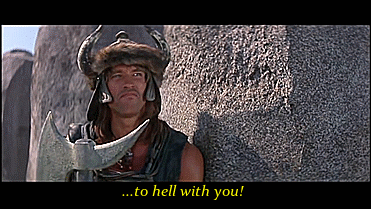Conan is exposed to various trials that form sub-programs of his initiatory quest. They exist to qualify him as being a hero, as "standing out": such as when he retrieves the Atlantantean sword or when he rescues the daughter of King Osric. These serve to train him, but also to show elements of his final transformation. For example, the time of slavery which gives him his wheel-amulet (representing his slavery to the dharmic law) and which he will only get rid of at the very end when he is liberated from everything (even the circle of life and death, but also his relation to Valeria, i.e. love). His first passage through the matrix (womb of the earth, i.e. the cave) gives him the sword which symbolizes the discipline of steel. His passage through the Tower in opposition to the serpent. His death and resurrection which condemns Valeria; and so on. All these symbolic deaths and symbolic resurrections follow one another in a cascade and eventually lead to the final rite of passage which acts as a post-liminal element that actualizes him as a "superman". The entire film transforms itself: from a myth told to Conan by his father, to a myth actualized by Conan himself. At the very least, the film comes to do what it says and says what it does within the film.
The entire film serves to show Conan's transformation. The transformation is that from a Conan who is subjected to the will of everything (to the gods, to the quests of others, to his putative parents of flesh and spirit, to his status as a slave, to Doom) to a Conan liberated from everything (even gods, that he invects, and false cults whose leader he executes). He "creates himself". In Conan's monologue before the final battle, he calls out Crom, calmly and serenely, reminding him that all is vanity and that no one will remember the work they are about to accomplish: he only wants one thing, revenge. Conan will have to go through the matrix three times, and then one death and resurrection to reach the end state revealed to him as he approaches Doom to kill him.







